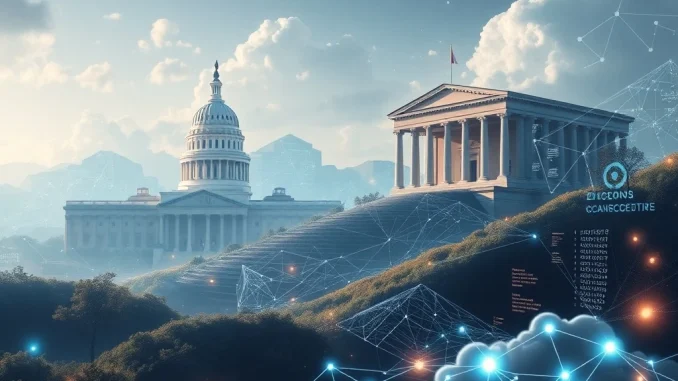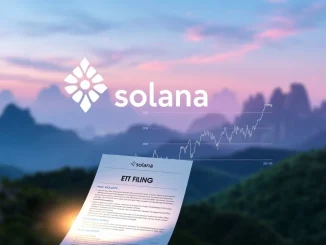
The cryptocurrency world is buzzing with recent developments that promise to reshape its future. From landmark legislative action to groundbreaking technological initiatives, the landscape of digital assets is evolving at an unprecedented pace. At the heart of this transformation lies the promise of enhanced blockchain innovation, driven by both policy and pioneering projects. Get ready to dive into how these forces are converging, sparking crucial debates and opening new avenues for growth in the crypto sphere.
GENIUS Act: A Monumental Leap for Crypto Regulation and Innovation
The U.S. House of Representatives recently passed the GENIUS Act (Generating Economic New Ideas for the U.S. Act) on June 26, 2025. This pivotal legislative move is designed to foster significant advancements in blockchain technology by providing a clear framework of tax incentives and much-needed regulatory clarity. This development has already sent ripples through the market, prompting investors and developers to strategically reposition themselves to capitalize on the new environment.
What Does the GENIUS Act Entail?
The GENIUS Act primarily aims to reduce compliance burdens for blockchain startups, making it easier for them to operate and innovate within the United States. Key provisions include:
- Tax Incentives: Offering breaks and credits for companies investing in blockchain research and development, particularly those focused on energy-efficient solutions. This incentivizes the adoption of ‘green’ technologies within the crypto space, aligning with broader environmental goals.
- Regulatory Clarity: Establishing clearer guidelines for digital asset classification, security offerings, and operational standards. This reduces legal ambiguity, a long-standing hurdle for many blockchain projects.
- Focus on Energy Efficiency: Prioritizing consensus mechanisms that consume less energy, which could accelerate the adoption of more sustainable blockchain models. This aligns with the goals of projects like IOTA, which inherently emphasize low-energy solutions.
Benefits and Criticisms of the GENIUS Act
While the GENIUS Act is largely seen as a positive step towards nurturing blockchain innovation, it’s not without its critics. Here’s a quick look at the pros and cons:
Benefits:
- Stimulates Investment: Tax incentives can attract significant capital into the blockchain sector, accelerating project development and market growth.
- Fosters Certainty: Clear regulations provide a more predictable operating environment, reducing risks for startups and established companies alike.
- Promotes Green Crypto: The emphasis on energy efficiency encourages the development and adoption of environmentally friendly blockchain technologies.
- Enhances Competitiveness: Positions the U.S. as a leader in blockchain technology, attracting global talent and innovation.
Challenges and Criticisms:
- Potential for Loopholes: Some experts warn that the broad scope of the act might create regulatory loopholes if enforcement is inconsistent, potentially enabling malicious actors.
- Implementation Hurdles: The effectiveness of the act will heavily depend on its practical implementation and how agencies interpret and enforce the new guidelines.
- Industry-Specific Nuances: Critics argue that a one-size-fits-all approach might not adequately address the unique challenges faced by different blockchain applications.
IOTA’s Bold Move: Free Cloud Mining Sparks Debate
Simultaneously with the GENIUS Act’s passage, IOTA, a Berlin-based distributed ledger project, unveiled a groundbreaking free cloud mining initiative. This move has amplified discussions around the feasibility and sustainability of its unique feeless transaction model, creating a fascinating juxtaposition with the regulatory advancements.
Understanding IOTA’s Free Cloud Mining Initiative
IOTA’s initiative allows users to participate in mining IOTA tokens without the need for upfront hardware investments. Traditionally, crypto mining requires expensive, specialized equipment and significant energy consumption. IOTA’s approach aims to democratize access to its network by:
- Lowering Barriers to Entry: Anyone with an internet connection can potentially participate, reducing the technical and financial hurdles that typically deter new participants.
- Driving Broader Adoption: By making participation easier, IOTA hopes to expand its user base and increase network activity, which is crucial for its Tangle architecture.
- Leveraging Cloud Infrastructure: The ‘cloud’ aspect implies that the computational burden is managed by remote servers, making it accessible to a wider audience.
The Feeless Transaction Model: IOTA’s Core Innovation
Unlike traditional blockchains that rely on transaction fees to incentivize miners, IOTA’s Tangle architecture is designed to be feeless. For every transaction sent, users must validate two previous transactions, contributing to the network’s security and validation process. This model is intended to:
- Enable Micro-transactions: Without fees, even tiny transactions become economically viable, opening doors for new use cases in the Internet of Things (IoT) and machine-to-machine payments.
- Enhance Scalability: As more users participate, the network theoretically becomes faster and more secure, avoiding the congestion issues seen in fee-based blockchains.
Polarized Reactions to IOTA’s Cloud Mining
The free cloud mining program has generated significant debate within the crypto community:
Advocates’ View:
- Democratization: Praised for making crypto participation accessible to the masses, potentially driving significant network growth.
- Innovation: Seen as a bold experiment in network bootstrapping and community engagement, pushing the boundaries of decentralized finance.
Skeptics’ Concerns:
- Sustainability: Questions arise about the long-term economic viability of a feeless network, especially if the incentive structure for validators isn’t clear or robust enough.
- Centralization Risks: Concerns that large cloud mining pools could lead to centralization of mining power, undermining the decentralized ethos.
- Network Congestion: While IOTA aims for scalability, a sudden surge in participants via free mining could test the network’s resilience and lead to unforeseen congestion issues.
- Economic Viability: In a post-GENIUS Act environment, competition among blockchain projects will intensify. IOTA’s model must prove its long-term sustainability against well-funded, fee-based alternatives.
The Dynamic Interplay: How GENIUS Act and IOTA Shape the Future
The convergence of the GENIUS Act and IOTA‘s free cloud mining initiative highlights the dynamic and often unpredictable nature of the crypto market. It underscores a crucial period where policy frameworks are beginning to align with industry needs, yet their success hinges on a delicate balance between fostering innovation and ensuring consumer protection.
Navigating the New Crypto Landscape
For the broader cryptocurrency sector, these developments represent both immense opportunities and significant challenges:
- Increased Scrutiny: As regulations become clearer, projects will face greater scrutiny regarding compliance, transparency, and operational integrity.
- Competitive Pressure: The tax incentives from the GENIUS Act could spur a new wave of startups, intensifying competition for market share and talent.
- Technological Evolution: The focus on energy-efficient mechanisms will accelerate the development of more sustainable and scalable blockchain solutions.
IOTA’s Test of Resilience
For IOTA, the free cloud mining initiative is a strategic move to expand its user base and a critical test of its network’s resilience under increased demand. The project must:
- Demonstrate Robustness: Prove that its Tangle architecture can handle a massive influx of new participants without compromising speed or security.
- Address Decentralization Doubts: Ensure that the free mining program doesn’t inadvertently lead to a concentration of power, maintaining the network’s decentralized nature.
- Showcase Scalability: Deliver on its promise of high scalability, especially as transaction volumes potentially surge.
The Road Ahead for Blockchain Innovation and Crypto Regulation
As stakeholders navigate these complex developments, critical uncertainties remain. The long-term impact of the GENIUS Act will depend heavily on its practical implementation and how effectively it supports blockchain innovation without compromising safeguards against illicit activities or market manipulation. Similarly, IOTA’s ability to maintain network integrity and economic viability amid rising participation will determine the success of its feeless model.
These scenarios underscore the inherent challenges of fostering growth in a sector still maturing. Managing regulatory and technical risks carefully will be paramount to ensuring sustainable progress and realizing the full potential of decentralized technologies. The interplay between groundbreaking legislation and bold technological experiments sets the stage for a fascinating era in cryptocurrency, where innovation, policy, and community engagement will collectively shape the future.
Frequently Asked Questions (FAQs)
Q1: What is the primary goal of the GENIUS Act?
The GENIUS Act aims to foster innovation in blockchain technology by offering tax incentives for research and development, providing regulatory clarity for digital assets, and prioritizing energy-efficient consensus mechanisms. Its core purpose is to ease compliance burdens for blockchain startups and stimulate economic growth in the sector.
Q2: How does IOTA’s free cloud mining work, and what are its potential benefits?
IOTA’s free cloud mining initiative allows users to participate in mining IOTA tokens without needing to purchase expensive hardware. This democratizes access to the network, lowers barriers to entry for new participants, and aims to drive broader adoption by making it easier for anyone to contribute to the network and earn tokens.
Q3: What are the main criticisms or concerns regarding the GENIUS Act?
Critics of the GENIUS Act primarily warn about the potential for inconsistent enforcement to create regulatory loopholes, which could be exploited by malicious actors. There are also concerns that its broad scope might not adequately address the nuanced challenges across various blockchain applications.
Q4: What are the risks associated with IOTA’s free cloud mining program?
Skeptics raise concerns about the sustainability of IOTA’s feeless model, potential centralization if large cloud mining pools dominate, and the risk of network congestion if participation surges beyond the network’s current capacity. There are also questions about the long-term economic viability of such a model in a competitive market.
Q5: How will the GENIUS Act impact the broader cryptocurrency market?
The GENIUS Act is expected to stimulate investment, provide greater regulatory certainty, and accelerate the development of green crypto technologies. It could intensify competition among blockchain projects while positioning the U.S. as a leader in blockchain innovation, attracting more talent and capital to the sector.
Q6: What makes IOTA’s feeless transaction model unique compared to traditional blockchains?
IOTA’s feeless model is based on its Tangle architecture, a Directed Acyclic Graph (DAG), rather than a traditional blockchain. Users sending a transaction must validate two previous transactions, eliminating the need for miners and transaction fees. This enables micro-transactions and aims for high scalability as the network grows, as opposed to fee-based blockchains that can suffer from congestion and high costs.



